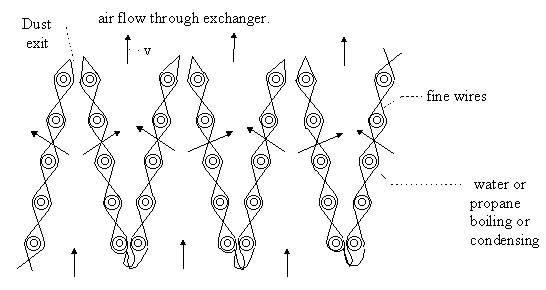The heat exchanger is a cloth, woven from tinned copper tube and tinned copper wire, soldered at every contact point. The air passes two layers of fine wires which causes high heat transfer and low pressure drop. Water, or condensing or evaporating heat pump fluid, flows through the tubes.

Fig 1. Cloth woven from tinned copper tubes and tinned copper wires, soldered together by hot air. Water flows through the tubes along the cloth and air flows through the wires, perpendicular to the cloth.
*When folded with a fold factor f, the air velocity through the mat is 1/f times the frontal velocity and price and heat transfer rise a factor f, but pressure drop lowers a factor f. The folds are cut open to avoid dust build-up.

Fig 2. Folded mat, woven from tinned copper wire and tube. The fold factor f (here about 5) increases the heat transfer and price, but decreases the air pressure drop.
Hand-woven prototypes of these mats have been made and measured in the research feasibility study and have the following characteristics: a is the heat transfer coefficient in W/m2K referring to the frontal surface and incoming air and water temperatures (take the smallest value of a), Dp is the air pressure drop in Pa over the exchanger, v is the frontal air velocity in m/s, m is the weight in kg / m2 of frontal surface, c is the fluid content in cm3 / m2 frontal surface, cp is the projected large scale manufacturing cost in ECU / m2:
a = 350(fv)0.5 or 800×v; Dp = 5.5×v1.8 / f ; m = f ; c = 5×f ; cp = 30×f
When the air speed is too low for the air to convey the energy, a= 800×v, 66% of the theoretical maximum of 1212×v, which is the specific heat of air times the moved quantity.
These folded mats with their water tubes connected to water distributing headers can be wrapped around large, slow turning fans, such that are ubiquitous in hot countries, that blow the air through them. Because of the very low pressure drop of about 6 Pa, these fans pump a large air flow of 900 l/s or 3200 m3/h with very low power of only 6 W.

Fig 3. Heat exchanger around air fan. The radial air speed is 1.8 m/s, the air speed through the heat exchanger is 0.45 m/s and the pressure drop 6.3 Pa including Bernouilli loss. The angle at which the air leaves the rotor is 75°, so no stator vanes are needed to direct the air flow radially. The rotor is driven at 280 RPM by a simple ceiling fan motor with a mechanical power of 6 W.
In order to transfer the heat with a low temperature difference, a lot of air has to be blown through the heat exchanger. As a result of the low pressure drop, very little power is needed for this air flow. The fan in fig 3 will heat a 100 m3 room with 10°C air in 3.3 minutes to 20°C with water of only 26°C.

Fig 4. Overview of the total assembly: heat exchanger, consisting of folded cloth woven from copper wires and capillaries connected to water distributing headers, wrapped around a centrifugal fan that blows air through it. This fan can heat air with water at 25°C, that can be fed with plastic tubes. No water valves are needed and temperature control can be achieved by speed variation. When the fan stops, there is no heat transfer.
Feedback on content: eur@fiwihex.com Feedback on layout: webmaster@fiwihex.com Last updated on May 24, 1999